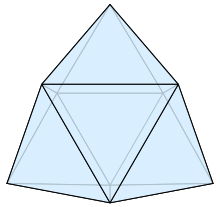Triaugmented triangular prism
| Triaugmented triangular prism | |
|---|---|
 | |
| Type | Deltahedron, Johnson J50 – J51 – J52 |
| Faces | 14 triangles |
| Edges | 21 |
| Vertices | 9 |
| Vertex configuration | |
| Symmetry group | |
| Dual polyhedron | Associahedron |
| Properties | convex |
| Net | |
 | |
The triaugmented triangular prism, in geometry, is a
The edges and vertices of the triaugmented triangular prism form a
The
Construction

The triaugmented triangular prism can be constructed by attaching
One possible system of
Properties
A triaugmented triangular prism with edge length has surface area[9]
It has the same three-dimensional symmetry group as the triangular prism, the dihedral group of order twelve. Its dihedral angles can be calculated by adding the angles of the component pyramids and prism. The prism itself has square-triangle dihedral angles and square-square angles . The triangle-triangle angles on the pyramid are the same as in the
Fritsch graph

The graph of the triaugmented triangular prism has 9 vertices and 21 edges. It was used by Fritsch & Fritsch (1998) as a small counterexample to Alfred Kempe's false proof of the four color theorem using Kempe chains, and its dual map was used as their book's cover illustration.[11] Therefore, this graph has subsequently been named the Fritsch graph.[12] An even smaller counterexample, called the Soifer graph, is obtained by removing one edge from the Fritsch graph (the bottom edge in the illustration here).[12][13]
The Fritsch graph is one of only six connected graphs in which the
Dual associahedron

The
More generally, when a polytope is the dual of an associahedron, its boundary (a simplicial complex of triangles, tetrahedra, or higher-dimensional simplices) is called a "cluster complex". In the case of the triaugmented triangular prism, it is a cluster complex of type , associated with the Dynkin diagram ![]()
![]()
![]()
![]()
![]() , the root system, and the cluster algebra.[18] The connection with the associahedron provides a correspondence between the nine vertices of the triaugmented triangular prism and the nine diagonals of a hexagon. The edges of the triaugmented triangular prism correspond to pairs of diagonals that do not cross, and the triangular faces of the triaugmented triangular prism correspond to the triangulations of the hexagon (consisting of three non-crossing diagonals). The triangulations of other regular polygons correspond to polytopes in the same way, with dimension equal to the number of sides of the polygon minus three.[15]
, the root system, and the cluster algebra.[18] The connection with the associahedron provides a correspondence between the nine vertices of the triaugmented triangular prism and the nine diagonals of a hexagon. The edges of the triaugmented triangular prism correspond to pairs of diagonals that do not cross, and the triangular faces of the triaugmented triangular prism correspond to the triangulations of the hexagon (consisting of three non-crossing diagonals). The triangulations of other regular polygons correspond to polytopes in the same way, with dimension equal to the number of sides of the polygon minus three.[15]
Applications
In the geometry of
In the Thomson problem, concerning the minimum-energy configuration of charged particles on a sphere, and for the Tammes problem of constructing a spherical code maximizing the smallest distance among the points, the minimum solution known for places the points at the vertices of a triaugmented triangular prism with non-equilateral faces, inscribed in a sphere. This configuration is proven optimal for the Tammes problem, but a rigorous solution to this instance of the Thomson problem is not known.[20]
See also
- Császár polyhedron – Toroidal polyhedron with 14 triangle faces
- Steffen's polyhedron – Flexible polyhedron with 14 triangle faces
References
- ^ S2CID 26955765
- ^ ISBN 978-3-642-68048-9
- ISBN 978-1-938664-15-1
- ISBN 9780520030565; see table, line 35
- MR 1572246
- MR 0021687
- S2CID 250435684
- ^ Francis, Darryl (August 2013), "Johnson solids & their acronyms", Word Ways, 46 (3): 177
- ^ MR 0290245; see Table IV, line 71, p. 338
- S2CID 122006114; see Table III, line 51
- MR 1633950
- ^
- ISBN 978-0-387-74640-1
- arXiv:1910.02708
- ^ S2CID 11435731; see Definition 3.3, Figure 3.6, and related discussion
- ISBN 978-1-938664-27-4
- S2CID 120914105; see polyhedron 9-IV, p. 301
- S2CID 14722555
- MR 0050303














